#Lunar Module Ascent Engine
Explore tagged Tumblr posts
Text
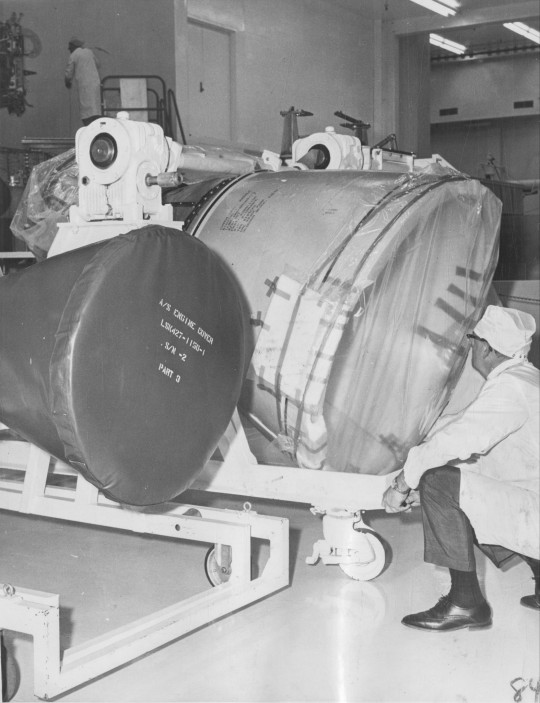
"Program administrator Albert Anderson is seen here with rocket engines involved in the Apollo Lunar Module Project."
Date: May 18, 1967
Long Island Daily Press Identifier: aql:16810 ldp-000238 ldp-000238
#Lunar Module#NASA#Apollo Program#Descent Propulsion System#Lunar Module Descent Engine#LMDE#Lunar descent stage propulsion#TRW VTR-10#Ascent Propulsion System#Lunar Module Ascent Engine#LMAE#Bell/Rocketdyne LMAE#Rocket Engine#Construction#Grumman Aerospace Corporation#Grumman#Factory#Bethpage#Long Island#New York#May#1967#my post
31 notes
·
View notes
Photo

2024 December 14
Apollo 17's Moonship Image Credit: Apollo 17, NASA, (Image Reprocessing: Andy Saunders)
Explanation: Awkward and angular looking, Apollo 17's lunar module Challenger was designed for flight in the near vacuum of space. Digitally enhanced and reprocessed, this picture taken from Apollo 17's command module America shows Challenger's ascent stage in lunar orbit. Small reaction control thrusters are at the sides of the moonship with the bell of the ascent rocket engine underneath. The hatch allowing access to the lunar surface is seen at the front, with a round radar antenna at the top. Mission commander Gene Cernan is clearly visible through the triangular window. This spaceship performed gracefully, landing on the Moon and returning the Apollo astronauts to the orbiting command module in December of 1972. So where is Challenger now? Its descent stage remains at the Apollo 17 landing site in the Taurus-Littrow valley. The ascent stage pictured was intentionally crashed nearby after being jettisoned from the command module prior to the astronauts' return to planet Earth.
∞ Source: apod.nasa.gov/apod/ap241214.html
187 notes
·
View notes
Text
GETTING TO THE MOON

On the Apollo missions, the lunar module was in a compartment stage beneath the command module engines. Once the ship had reached a certain distance, that stage would separate and free the lunar module.

The command module would then dock with the lunar module. The spacecraft then continued on to lunar orbit in thesis configuration.
Upon arrival at the separation point, two astronauts would crawl through a pressurized tunnel from the command module into the lunar module. The third astronaut remained in the command module, orbiting above the moon.

The lunar module then separated and proceeded to its landing point. The lunar module (or LEM - Lunar Excursion Module, as it was referred to at this point) became home for the two astronauts during their brief stay on the moon.
-Apollo 11 stayed 21 hrs 36 mins
-Apollo 12 stayed 31.6 hrs
-Apollo 13 never landed
-Apollo 14 stayed 33 hrs
-Apollo 15 stayed 67 hrs
-Apollo 16 stayed 71 hrs
-Apollo 17 (the last men on the Moon) stayed just seconds shy of 75 hrs.

For departure the top half of the LEM, or ascent stage, would fire its rockets and ascend into lunar orbit to rendezvous with the command module. The descent stage was left behind on the lunar surface.
Once the ascent stage had docked with the command module the astronauts would transfer back. The ascent stage was then jettisoned, and all three astronauts rode the command module back to Earth to splashdown somewhere in the ocean.
Just a reminder of what REAL astronauts experienced back in the day. Meanwhile, in present times, everyone seems to be going ga-ga over a bunch of celebrities who central high and experienced a brief moment of zero-G.
#Apollo#command module#lunar module#LEM#Lunar Excursion Module#moon landing#it's real!#NASA#space travel#real space travel
9 notes
·
View notes
Text
Unfinished Timeline for an Untitled Setting
Critique and advice is more than welcome, though please be nice about it. Goes up to about 2081 rn, though I plan to get at least another 50 years further in before I get to the time I want the bulk of the setting to be set in.
Timeline:
2022: First controlled break-even fusion reaction, followed by first controlled net-gain fusion reaction.
2025-2026: Increasing unrest in USA leads to mass riots outside the white-house. Sweeping reforms after growing revolts threaten to become a major armed rebellion. NASA miraculously left untouched, general increase in standard of living. Economic crisis narrowly averted.
2027: First nuclear thermal rocket (NTR) tested in orbit by NASA and DARPA. GPT-style language modeling declared “dead end” for self-aware AI.
2030: First Lunar base established under NASA Artemis program. Suez Canal temporarily blocked by a poorly driven cargo ship again. Evergreen Shipping goes bankrupt.
2034: Lunar Gateway established under joint NASA, ESA, JAXA, DLR, ASI, and CNSA. Lunar helium-3 mining declared officially nonviable. Radial detonation engines become standard for lower ascent stages, SpaceX Starship, NASA SLS, and Roscosmos Soyuz phased out. Drop in launch prices.
2034-2036: Additional modules added to the Lunar Gateway from SpaceX, KARI, ISRO, and Roscosmos. Lunar Gateway Collaborative Group (LGCG) established consisting of all current contributors to the station.
2036: First commercial fusion energy plant reaches full operation in France under ITER. Mass production of Tritium begins. First fully private space station under SpaceX. Asteroid mining corporations begin formation. Establishment of Nigerian Organization for the Development of Space (NODS). Ecuador experiences communist revolution.
2036-2037: First manned martian mission under LGCG, first human footsteps on another planetary body.
2037: Elon Musk assassinated. New SpaceX leadership declares plans for space elevator. North Korea collapses, Korean peninsula unified under South Korean leadership, becoming simply Korea. Indian nuclear stockpile secretly surpasses 50000 Gt. First baby born on the moon.
2040: Artemis base becomes semi-self sufficient, producing it’s own food and air from hydroponics, and water from mined lunar ice. Lunar LH2 and hydrolox production begins. Lunar population passes 100.
2040-2042: First commercial fusion power plants established in the US, UK, Australia, Korea, and Japan.
2042: A joint US Government and SpaceX black operation destabilizes Ecuador, leading to a corporate takeover of the territory.
2044: Korea, Japan, the Philippines, Vietnam, Malaysia, Indonesia, Papua New Guinea, Australia, and New Zealand form West Pacific Trade Organization (WPTO). Construction of the base of SpaceX’s planned space elevator begins off the coast of Ecuador.
2047: LCC completed at CERN. Mission for permanent martian base declared. Major economic crisis in China, intervention from several megacorps results in a decrease in Chinese government power and increase in corporate control in the region. SpaceX space elevator counterweight construction begins in geostationary orbit.
2048: Major revolution in quantum mechanics brought on by new data from the LCC. Lunar population passes 250.
2050: China splits into 4 corporate states, Amazon Corporate Territory (ACT) with its capitol in Chongqing, Samsung Independent State (SIS) with its capitol in Shanghai, Territory for Electronic Developments (TED) made up of Apple and Microsoft with its capitol in Yinchuan, and the Chinese Corporate Union (CCU) made up of several formerly state-owned corporations with their capitol in Wuhan and possession of the Three Gorges Dam. Beijing becomes an independent city-state controlled by the former Chinese government, retaining control over the CNSA. Massive revolution in battery energy density. Permanent martian base established by LGCG.
2051: Breakthrough in photon manipulation, beamed energy and solar collection becomes increasingly viable. Many asteroid mining corps branch into solar power, notably Binghamton Vacuum Mining Solutions (BVMS). Lunar population passes 500.
2052: Martian population surpasses 100.
2053: Martian base reaches semi-self sustainability.
2055: All 4 Chinese corporate states and the Beijing city state form the Chinese Federation for Space Exploration (CFSE), supplanting the old CNSA. Lunar Gateway module renamed and LGCG roster amended accordingly. SpaceX space elevator cable completed, first test cart sent to GEO. WPTO begins construction of a space elevator in the Banda Sea.
2056: SpaceX space elevator declared complete, commercial operation begins.
2057: BVMS surpasses $1T in net worth, becomes primary supplier of energy for the Artemis Lunar Base. Lunar Population surpasses 1k, massive migratory population surge begins following influx of energy from BVMS. Martian population surpasses 250. First fusion reactor in Ecuador.
2058: WPTO space elevator counterweight begins construction in GEO.
2060: First fusion reactors in Nigeria and India. First large-scale solar collector on Earth constructed in New York operated by BVMS. Large population surge in Binghamton NY. Lunar population surpasses 5k. Martian space station established. Regulations for GEO development established.
2061: First lunar-built spacecraft flown. Secondary lunar settlement founded by CFSE. Massive influx of funds for the WPTO space elevator from the CFSE, GEO counterweight construction begun. Lunar Gateway population surpasses 100. First fusion reactor in the Democratic Republic of the Congo (DRC), Congo space agency (DRCSA) founded.
2064: WPTO space elevator cable completed, declared complete and opened to commercial operation.
2065: BVME establishes unmanned Mercurian base. CFSE settlement population surpasses 100. Martian population surpasses 500. Lunar Gateway population surpasses 200.
2066: Mass expansion of Artemis Base life support systems using BVMS produced automated construction equipment. Aerostat scientific outpost established by LGCG.
2067: Microbial life discovered on Venus. Venus outpost (and LGCG) acquires substantial funding boost. Artemis base population surpasses 2.5k and begins to plateau.
2069: Unmanned mission to Europa announced by LGCG, plans to use BVMS automated platforms to drill into subsurface ocean established. Martian base purchases automated construction equipment from BVMS, massive population boon ensues. CFSE settlement population surpasses 750. Lunar gateway population surpasses 500. Martian base population surpasses 500. BVME becomes the largest corporate entity in the system.
2070: BVMS performs feasibility study on gas giant aerostat mining platforms.
2071: Study of Venusian lifeforms disproves Earth-Venus panspermia.
2073: BVMS tests laser-sail propulsion on small unmanned craft.
2075: LGCG Europa mission discovers multicellular aquatic life in Europa’s subsurface ocean. Plans for a dedicated research base drafted.
2076: Multi-corporate base established on Ceres to facilitate further asteroid belt mining. BVMS intentionally excluded from this project.
(System effectively split into quarters: Past Venus under BVMS, Between Venus and Mars under LGCG, belt under Multi-corporate mining control, outer system unclaimed.)
2077: GEO-Lunar cycler niche mostly filled by Intraplanetary Transport Services corp (ITS).
2080: Permanent scientific base established at the Europa Breach Point (EBP) with mostly automated systems and a small (5 human) management and maintenance crew.
2081: Panspermia further disproved by study of Europan life. Massive object detected in Jupiter’s lower atmosphere. BVMS begins mission to establish a mining aerostat on Saturn, utilizing laser sail propulsion to transport equipment.
(Saturn Aerostat site intended for use in the further colonization of the outer solar system and the Uranus planetary system itself. Atomic Rockets page)
14 notes
·
View notes
Text

NASA Marshall fires up hybrid rocket motor to prep for moon landings
NASA's Artemis campaign will use human landing systems, provided by SpaceX and Blue Origin, to safely transport crew to and from the surface of the moon, in preparation for future crewed missions to Mars. As the landers touch down and lift off from the moon, rocket exhaust plumes will affect the top layer of lunar "soil," called regolith, on the moon. When the lander's engines ignite to decelerate prior to touchdown, they could create craters and instability in the area under the lander and send regolith particles flying at high speeds in various directions.
To better understand the physics behind the interaction of exhaust from the commercial human landing systems and the moon's surface, engineers and scientists at NASA's Marshall Space Flight Center in Huntsville, Alabama, recently test-fired a 14-inch hybrid rocket motor more than 30 times. The 3D-printed hybrid rocket motor, developed at Utah State University in Logan, Utah, ignites both solid fuel and a stream of gaseous oxygen to create a powerful stream of rocket exhaust.
"Artemis builds on what we learned from the Apollo missions to the moon. NASA still has more to learn more about how the regolith and surface will be affected when a spacecraft much larger than the Apollo lunar excursion module lands, whether it's on the moon for Artemis or Mars for future missions," said Manish Mehta, Human Landing System Plume & Aero Environments discipline lead engineer.
"Firing a hybrid rocket motor into a simulated lunar regolith field in a vacuum chamber hasn't been achieved in decades. NASA will be able to take the data from the test and scale it up to correspond to flight conditions to help us better understand the physics, and anchor our data models, and ultimately make landing on the moon safer for Artemis astronauts."
Of the 30 test fires performed in NASA Marshall's Component Development Area, 28 were conducted under vacuum conditions and two were conducted under ambient pressure. The testing at Marshall ensures the motor will reliably ignite during plume-surface interaction testing in the 60-ft. vacuum sphere at NASA's Langley Research Center in Hampton, Virginia, later this year.
Once the testing at NASA Marshall is complete, the motor will be shipped to NASA Langley. Test teams at NASA Langley will fire the hybrid motor again but this time into simulated lunar regolith, called Black Point-1, in the 60-foot vacuum sphere. Firing the motor from various heights, engineers will measure the size and shape of craters the rocket exhaust creates as well as the speed and direction the simulated lunar regolith particles travel when the rocket motor exhaust hits them.
"We're bringing back the capability to characterize the effects of rocket engines interacting with the lunar surface through ground testing in a large vacuum chamber—last done in this facility for the Apollo and Viking programs. The landers going to the moon through Artemis are much larger and more powerful, so we need new data to understand the complex physics of landing and ascent," said Ashley Korzun, principal investigator for the plume-surface interaction tests at NASA Langley.
"We'll use the hybrid motor in the second phase of testing to capture data with conditions closely simulating those from a real rocket engine. Our research will reduce risk to the crew, lander, payloads, and surface assets."
Through the Artemis campaign, NASA will send astronauts to explore the moon for scientific discovery, economic benefits, and to build the foundation for the first crewed missions to Mars—for the benefit of all.
4 notes
·
View notes
Text
An even bigger Saturn V
The Saturn V has not been launched since 1973, but it remains the spacecraft that has carried the heaviest load to orbit (is this post out of date yet? Don't fact-check me). It's not alone in the Saturn family. There were the Saturn I and IB, a smaller rocket that was used to test the rocket motor's viability and then space-rate the people-holding stuff on Apollos 5 and 7.
And then we get to the big one, the Saturn V. The bottommost S-1C stage was powered by five F-1 engines. The F-1 engine remains, to this day, the most powerful single-chamber rocket motor ever built. So what if I told you there were plans for an even more powerful member of the Saturn family?

It never got off the drawing board, but the Saturn C-8 was planned to use eight of these most-powerful-ever engines, and have a mass nearly twice that of the Saturn V. Why didn't it get built? It wasn't because NASA's budget fell off halfway through the Apollo program (there were even Apollo 18, 19, and 20 landings planned that got shelved). It's because the C-8 was designed before the Saturn V.
The way the Apollo astronauts got to the Moon was with a flight pattern called lunar orbit rendezvous. To say it's complicated is a tiny understatement, but the idea is to have multiple vehicles for the process, each with their own job. The bulk of the Saturn V got the astronauts out of Earth orbit and then pointed toward the Moon. Once at the Moon, a small burn was done to keep the spacecraft orbiting it. And then, the craft splits in two. Michael Collins gets to watch from the Command Module while Armstrong and Aldrin have fun landing in the Lunar Module.

The Saturn C-8 was designed for a much simpler lunar approach which made things, in practice, more complicated. It was called "direct ascent". Apollo spacecraft approaches the Moon, the whole thing lands on the Moon, and then takes off. Michael Collins doesn't have to be the "loneliest man in existence" while orbiting the dark side of the Moon. But due to the tyranny of the rocket equation, which would make this post way too long to explain, lunar orbit rendezvous was chosen as the way to go, and we never got our behemoth C-8.
Thanks to Kerbal Space Program for the images, supplying authentic space exploration data and concept since 2015.

0 notes
Text
Apollo 17's Moonship
Awkward and angular looking, Apollo 17’s lunar module Challenger was designed for flight in the near vacuum of space. Digitally enhanced and reprocessed, this picture taken from Apollo 17’s command module America shows Challenger’s ascent stage in lunar orbit. Small reaction control thrusters are at the sides of the moonship with the bell of the ascent rocket engine underneath. The hatch…
0 notes
Text
Apollo 17 s Moonship
Awkward and angular looking, Apollo 17’slunar module Challenger was designed for flight in the near vacuum of space. Digitally enhanced and reprocessed, this picture taken from Apollo 17’s command module America shows Challenger’s ascent stage in lunar orbit. Small reaction control thrusters are at the sides of the moonship with the bell of the ascent rocket engine underneath. The hatch allowing…
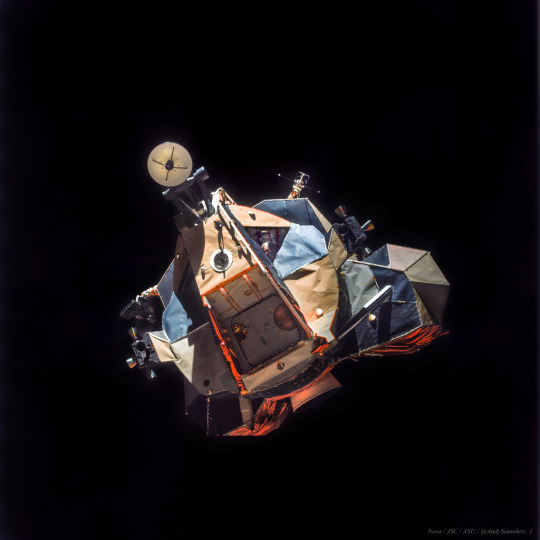
View On WordPress
0 notes
Text
Space History...
Rarely-seen view of an Apollo Lunar Module ascent stage...
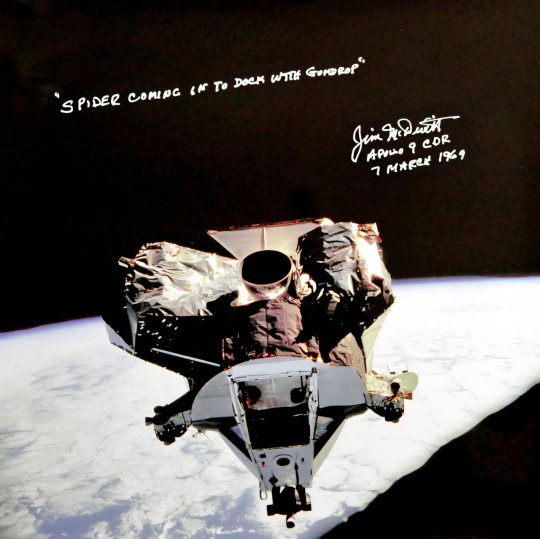
After flying separately in Earth orbit to test the various systems and engines, the Apollo 9 LM SPIDER ascent stage returns to the CSM to dock. Right in the center is the nozzle of the ascent propulsion system engine that would be the crews ride for getting off the Moon.
I have no patience with moon-landing denier conspiracy theorists. One of their arguments is that the LM is too wobbly and flimsy-looking to fly anywhere, let alone to the Moon. I'll use this photo to shoot holes in one of their arguments. Part of what you see there is indeed uneven and wrinkly, but that is NOT the structure of the spacecraft. While it had to be light, the LM is made of very strong materials, meticulously engineered to withstand the forces that it would be subjected to. What is visible here is merely insulation... stacks of thin sheets of steel and inconel-x foil to protect the structure from the heat of the engine. The gold and black surfaces on the rest of the spacecraft are the same.. sheets of metal foil and gold-coated mylar plastic that shields the spacecraft from the heat and cold of space. The actual structure of the LM was made of much sterner stuff.
The only thing the conspiracy theorists prove is that they don't understand what they are looking at and should sit down and shut up.
0 notes
Text
Like rockets (perpendicular to the direction of travel)
Nitpick time: this only makes sense if you're comparing soft scifi ships with hypothetical "torch ships" that sustain physiologically significant acceleration for the entire flight like Derin mentioned. Manned spacecraft built with current technology generally have stuff that's meant to be used when under acceleration laid out parallel to the direction of travel. I.e. the seats in the Apollo capsules, or Soyuz reentry module, or Orion, or Crew Dragon, or the Space Shuttle, are all oriented so you're facing towards the nose of the vehicle, and when under acceleration you're pushed "backward" into your seat. When the vehicle is vertical on the launch pad, you're lying on your back, and the same thing after the capsule lands.
This is done because these vehicles only accelerate for minutes to tens of minutes at a time, but the peak acceleration can be several times the force of gravity on a nominal launch or reentry. In the event of an emergency the Launch Escape Systems on capsule type spacecraft can exceed 10 gs for a couple seconds IIRC, and the steeper than normal reentry in an abort scenario can also produce g forces that high, plus there's a brief spike of very high acceleration on landing. The human body tolerates those forces better lying on your back than sitting upright: your heart doesn't have to pump blood as far against gravity, and it's easier on your spine.
(the Space Shuttle is a special case: the felt "gravity" was backward for launch, downward for reentry. However, the Shuttle's massive wings allowed it to have a more gradual reentry than most spacecraft and a runway touchdown is gentler than typical capsule touchdowns. The stuff about the LES and abort scenario reentries also doesn't apply because the shuttle was a piece of shit deathtrap didn't have a conventional launch escape system and was really only designed for abort modes where the vehicle could ride its remaining functional engines to a point where it could safely separate from the external tank and/or SRBs in the normal slow, gentle way)
The Apollo Lunar Modules were an exception to this, but the fastest the LEM could possibly accelerate was only about 0.75 g (ascent stage at full throttle with empty propellant tanks), which is low enough that the crew were not just upright but standing up during landing and launch.
The other exception is Blue Origins' suborbital New Shepard Capsule; the seats in it all have the passengers basically lying on their backs, but the passengers' feet are all pointing in different directions and it flies straight up and straight down without major changes in the vehicle's orientation.
1K notes
·
View notes
Text
Apollo Missions: Apollo 5

A schematic highlighting the major milestones of the Apollo 5 mission to test LM-1.
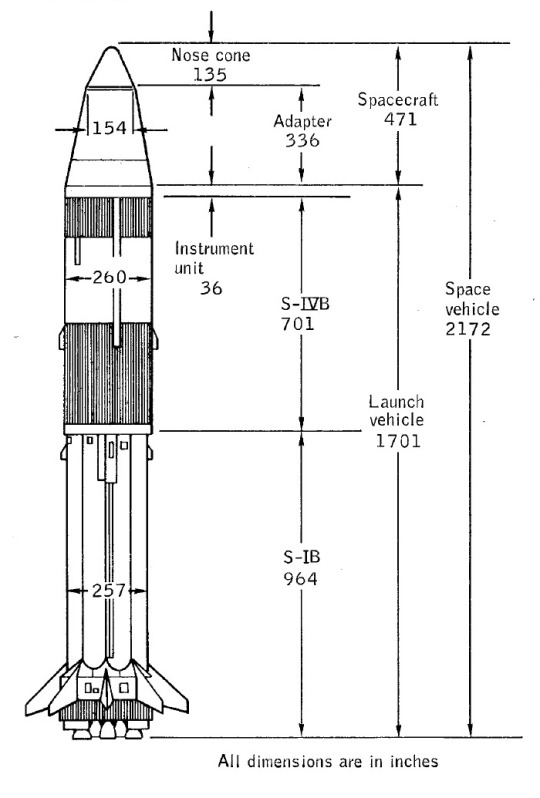
Diagram of the Saturn IB used for the unmanned LM-1 test flight.
"A nearly perfect performance by the Saturn IB placed the S-IVB-204 stage and its LM-1 payload into an initial 163 by 222 kilometer orbit with an inclination of 31.6° following 10 minutes and 3.3 seconds of powered flight. After 35 seconds in orbit, the nose cone was successfully jettisoned with the four panels of the SLA deployed 9 minutes and 15 seconds later. LM-1 used its RCS to separate from S-IVB-204 at 23:38:58 GMT about halfway through its first revolution and into a 167 by 224 kilometer orbit. After separation, LM-1 changed its attitude to cold soak its propulsion system for the next two orbits.
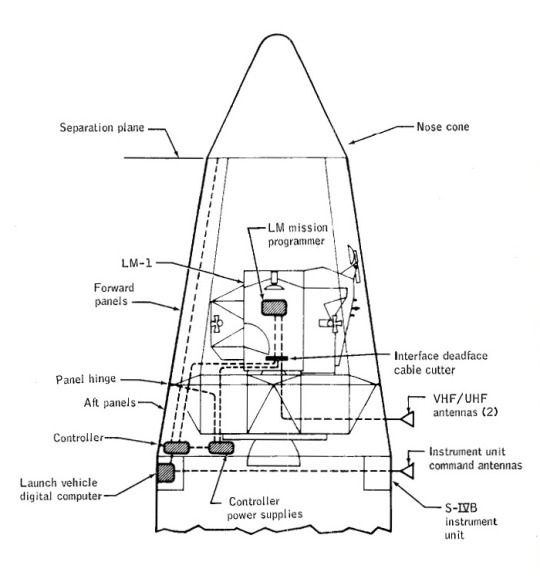
Diagram showing the configuration of LM-1 inside of its Spacecraft Launch Adapter (SLA).
With its primary duties concluded, S-IVB-204 performed a number of engineering tests including the dumping of residual cryogenic propellants and helium pressurant through the stage’s J-2 engine. This procedure would help lighten the stage for easier control in orbit and prepare future S-IVB stages for use as a 'wet' orbital workshop as proposed for the Apollo Application Program which was planned to follow the initial Apollo lunar landing missions (a program which later evolved into Skylab). After the propellant dump was successfully completed at 01:19:33 GMT on January 23, the stage was in a 155 by 223 kilometer orbit. Although it was not tracked, the orbit of S-IVB-204 was expected to decay ten revolutions after the separation of LM-1 about 15½ hours after launch.




An artist conception of LM-1 separating from its spent S-IVB stage.
Following the three-hour cold soak of LM-1, a pair of burns were planned for the descent propulsion system (DPS) followed by two burns of the ascent propulsion system (ASE). The first 39-second burn of the DPS would start at a throttle setting of 10% then ramp up to full thrust for the last 12 seconds to simulate the initial deorbit burn which would start the descent towards the lunar surface. The second firing of the DPS would last for 739 seconds and use a series of throttle settings representative of an actual descent to the lunar surface. Immediately afterwards, the abort staging would be tested with an initial five-second burn of the APS. A subsequent firing of the APS would continue until the stage’s propellants were depleted after about 445 seconds completing the primary mission about 6½ hours after launch. Because the LM ascent stage was expected to be left in a comparatively long-lived 315 by 815 kilometer orbit after the completion of the last APS burn, extended mission activities were planned until the ascent stage depleted its consumables about seven hours later.

-Animation of LM-1 in orbit
At 02:47:49 GMT on January 23 (just shy of four hours after liftoff), LM-1 was commanded to start the first of two planned burns of the DPS but the engine unexpectedly shutdown after firing for only four seconds leaving the spacecraft in a 170 by 222 kilometer orbit instead of the planned 215 by 330 kilometer orbit. After examining the telemetry, ground controllers quickly located the source of the problem. The LM’s guidance computer had been programmed to abort the maneuver and shutdown the DPS if it did not provide the expected acceleration level after four seconds – a situation which would normally indicate a problem with the DPS. Because the pressure-fed propulsion system was purposely running at lower than nominal pressure for these tests, it would now take six seconds to reach full thrust. It was this oversight which resulted in the premature shutdown of the DPS.

Cutaway diagram of LM-1 used for the first unmanned test flight of the Lunar Module (LM)
As a result of the problem, a preplanned alternate mission was adopted by ground controllers which would meet the minimum mission requirements while keeping LM-1 in touch with tracking stations for key maneuvers.

An artist conception of the firing of the LM descent propulsion system (DPS) during the Apollo 5 mission.
With the guidance system deactivated, the DPS was ignited by ground command for a 33-second burn at 04:58:49 GMT during the fourth revolution. The second burn of the DPS for the alternate mission sequence was commanded at 04:59:54 GMT for an abbreviated 28-second burn.

This was followed by the abort staging test and a 60-second burn of the APS. All systems worked as intended during this alternate mission’s three burns. The 228 meter per second total change in velocity from these three propulsive maneuvers boosted LM-1 into a 172 by 961 kilometer orbit.

-Animation of LM-1 Ascent Stage in orbit.
After these first three firings of the propulsion systems, the primary control system was reactivated for the balance of the mission. Unfortunately the guidance computer, which had been in a passive mode during the abort staging, had not taken into account the change in spacecraft mass and used excessively long burns of the RCS to control attitude as if it had a fully loaded descent stage still attached. This resulted in higher than expected RCS usage and eventual propellant depletion after only about an hour. Fortunately the RCS could be configured to draw from the APS propellant supply to provide attitude control during the mission’s final burn. Because of the timing and other requirements of the burns in the alternate mission plan, this second burn of the APS would be in the retrograde direction which would send the spacecraft into Earth’s atmosphere ending the Apollo 5 mission.
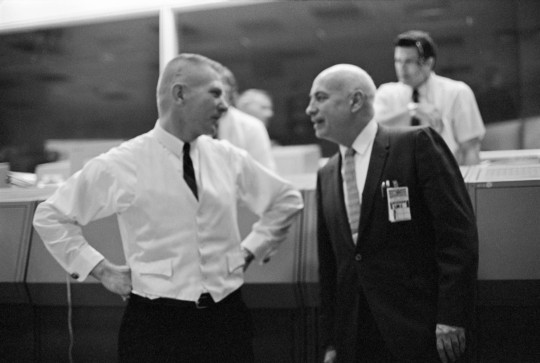
Flight Director Gene Kranz (left) and Dr. Gilruth (right) shown in the Mission Control Center at the conclusion of the Apollo 5 mission
With the ground track of LM-1 beginning to drift beyond the mission’s tracking stations due to the one-orbit delay to implement the alternate mission, the remainder of the mission had to be completed by the next revolution. The second burn of the APS started at 06:32:20 GMT during the fifth revolution. As planned, the sequencer automatically closed the valves supplying the RCS with propellant about 161 seconds later. Without attitude control, the ascent stage began to tumble as the APS continued to fire for another 190 seconds before its propellants were finally depleted. The last telemetry was received from LM-1 at 06:40:18 GMT on January 23 ending the Apollo 5 mission 7 hours, 52 minutes and 10 seconds after launch. The LM-1 ascent stage reentered the Earth’s atmosphere and was destroyed over the Pacific Ocean some 640 kilometers off the coast of Central America. The inactive descent stage of LM-1 fell from orbit on February 12.
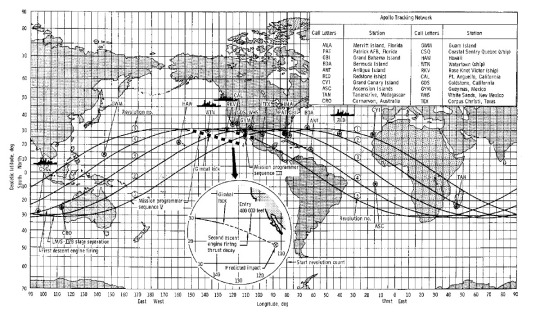
"Map showing the ground track of the Apollo 5 mission as flown and the location of tracking stations supporting the mission.
Although the Apollo 5 mission had encountered problems forcing a switch to an alternate mission plan, the overall performance of LM-1 was good enough to satisfy the mission’s main objectives. And with the requirement to certify the LM for crewed test flights satisfied, a potential second unmanned test flight with LM-2 was cancelled allowing one more mission to be cut from the Apollo program’s increasingly tight schedule. With LM-2 being unsuitable for manned flight without significant reworking to meet new requirements in the wake of the Apollo 1 fire, it was set aside as work continued on LM-3 for the first manned LM test flight on Apollo 9."
-information from DrewExMachina: link
#Apollo 5#Lunar Module#LM-1#SLA-7#Saturn IB#SA-204#Rocket#NASA#Apollo Program#B-type mission#January#1968#Gif#my post
99 notes
·
View notes
Link
As NASA continues to ramp up efforts for its Artemis program, which has the goal of landing the first woman and person of color on the lunar surface, two NASA astronauts recently conducted training with a replica of SpaceX’s Starship human landing system (HLS), albeit on a much smaller scale. Given that Starship is 50 meters (160 feet) tall, and the crew quarters are located near the top of Starship, the HLS will need an elevator with a basket to transport crew and supplies from the crew quarters down to the surface. The purpose of this training is to familiarize astronauts with all aspects of this system, including elevator and gate controls and latches, along with how the astronauts perform these tasks in their bulky astronaut suits, which both astronauts wore during the training. The two NASA astronauts who participated in the recent training are Nicole Mann and Doug “Wheels” Wheelock. NASA Astronaut Mann is a Colonel in the United States Marine Corps who was selected as a NASA astronaut in the 2013 NASA Group 21. Her spaceflight experience includes 157 days in space as part of Expedition 68 onboard the International Space Station (ISS) and being launched aboard the SpaceX Crew-5 mission. NASA Astronaut Wheelock is a Colonel in the United States Army who was selected as a NASA astronaut in the 1998 NASA Group. His spaceflight experience includes 178 days in space as part of STS-120 and later as part of Expedition 24/25 on the ISS and being launched aboard the Soyuz TMA-19. As noted, Starship is 50 meters (160 feet) tall and 9 meters (30 feet) in diameter and capable of landing 100 tons (99,790 kilograms/220,000 pounds) on the lunar surface, which is in stark contrast to the Apollo lunar module that landed 12 men on the lunar surface during the Apollo program, which was only 5.5 meters (17.9 feet) tall and approximately 4.3 meters (14 feet) in diameter and a mass of 15,103 kilograms (33,296 pounds) with fuel. Ironically, the original plan for landing astronauts on the Moon during the Apollo program was known as direct ascent that involved a single, large vehicle with a payload of 74,000 kilograms (163,000 pounds) landing on the lunar surface. While NASA was in favor of using the direct ascent method in early 1961 since spacecraft rendezvous and docking had not been performed in Earth orbit yet, this was later scrapped in favor of the lunar orbit rendezvous (LOR) mission mode that was advocated by NASA aerospace engineer, John Houbolt, who estimated this would significantly reduce the weight involved in such a landing approach. LOR not only successfully landed six Apollo missions on the Moon, but it was also responsible for saving the Apollo 13 crew when one of their oxygen tanks ruptured and the crew was able to use the lunar module as a lifeboat as they flew around the Moon and came back to Earth. As NASA astronauts train for using the Starship HLS elevator someday, Starship has already conducted two flight tests—Ship 24 in April 2023 and Ship 25 in November 2023, respectively. While both flights ended in failure, Ship 25 officially passed the Karman Line, which is the traditional boundary of outer space. A third Starship test flight is currently scheduled to occur sometime in the first quarter of 2024, which also comes as the crewed Artemis II mission is gearing up for their 10-day mission orbiting the Moon in November 2024 and Artemis III currently scheduled to land astronauts near the lunar south pole sometime in 2025. How will Starship HLS help future Artemis astronauts on the lunar surface in the next few years? Only time will tell, and this is why we science! As always, keep doing science & keep looking up! The post NASA Astronauts are Trying Out the Starship Lunar Elevator appeared first on Universe Today.
0 notes
Text
Happy Moon Day!
At 10:56 p.m. EDT, American astronaut Neil Armstrong, 240,000 miles from Earth, speaks these words to more than a billion people listening at home: “That’s one small step for a man, one giant leap for mankind.” Stepping off the lunar module Eagle, Armstrong became the first human to walk on the surface of the moon.
The American effort to send astronauts to the moon has its origins in a famous appeal President John F. Kennedy made to a special joint session of Congress on May 25, 1961: “I believe this nation should commit itself to achieving the goal, before this decade is out, of landing a man on the moon and returning him safely to the Earth.” At the time, the United States was still trailing the Soviet Union in space developments, and Cold War-era America welcomed Kennedy’s bold proposal.
In 1966, after five years of work by an international team of scientists and engineers, the National Aeronautics and Space Administration (NASA) conducted the first unmanned Apollo mission, testing the structural integrity of the proposed launch vehicle and spacecraft combination. Then, on January 27, 1967, tragedy struck at Cape Canaveral Space Force Station in Cape Canaveral, Florida, when a fire broke out during a manned launch-pad test of the Apollo spacecraft and Saturn rocket. Three astronauts were killed in the fire.
Despite the setback, NASA and its thousands of workers forged ahead, and in October 1968, Apollo 7, the first manned Apollo mission, orbited Earth and successfully tested many of the sophisticated systems needed to conduct a moon journey and landing. In December of the same year, Apollo 8 took three astronauts around the far side of the moon and orbited it 10 times before returning, and in March 1969 Apollo 9 tested the lunar module for the first time while in Earth orbit. Then in May, the three astronauts of Apollo 10 took the first complete Apollo spacecraft in 31 orbits around the moon in a dry run for the scheduled July landing mission.
At 9:32 a.m. on July 16, with the world watching, Apollo 11 took off from Kennedy Space Center with astronauts Neil Armstrong, Edwin Aldrin Jr., and Michael Collins aboard. Armstrong, a 38-year-old research pilot, was the commander of the mission. After traveling 240,000 miles in 76 hours, Apollo 11 entered a lunar orbit on July 19. The next day, at 1:46 p.m., the lunar module Eagle, manned by Armstrong and Aldrin, separated from the command module, where Collins remained. Two hours later, the Eagle began its descent to the lunar surface, and at 4:18 p.m. the craft touched down on the southwestern edge of the Sea of Tranquility. Armstrong immediately radioed to Mission Control in Houston, Texas, a famous message: “The Eagle has landed.”
At 10:39 p.m., five hours ahead of the original schedule, Armstrong opened the hatch of the lunar module. As he made his way down the lunar module’s ladder, a television camera attached to the craft recorded his progress and beamed the signal back to Earth, where hundreds of millions watched in great anticipation. At 10:56 p.m., Armstrong spoke his famous quote, which he later contended was slightly garbled by his microphone and meant to be “that’s one small step for a man, one giant leap for mankind.” He then planted his left foot on the gray, powdery surface, took a cautious step forward, and humanity had walked on the moon.
“Buzz” Aldrin joined him on the moon’s surface at 11:11 p.m., and together they took photographs of the terrain, planted a U.S. flag, ran a few simple scientific tests, and spoke with President Richard M. Nixon via Houston. By 1:11 a.m. on July 21, both astronauts were back in the lunar module and the hatch was closed. The two men slept that night on the surface of the moon, and at 1:54 p.m. the Eagle began its ascent back to the command module. Among the items left on the surface of the moon was a plaque that read: “Here men from the planet Earth first set foot upon the moon–July 1969 A.D–We came in peace for all mankind.”
At 5:35 p.m., Armstrong and Aldrin successfully docked and rejoined Collins, and at 12:56 a.m. on July 22 Apollo 11 began its journey home, safely splashing down in the Pacific Ocean at 12:51 p.m. on July 24.
There would be five more successful lunar landing missions, and one unplanned lunar swing-by, Apollo 13. The last men to walk on the moon, astronauts Eugene Cernan and Harrison Schmitt of the Apollo 17 mission, left the lunar surface on December 14, 1972. The Apollo program was a costly and labor-intensive endeavor, involving an estimated 400,000 engineers, technicians, and scientists, and costing $24 billion (close to $100 billion in today’s dollars). The expense was justified by Kennedy’s 1961 mandate to beat the Soviets to the moon, and after the feat was accomplished ongoing missions lost their viability.
1 note
·
View note
Text
Orion’s top images of 2020
The Orion program showed its resilience this year during an unprecedented time, racking up several success stories building and testing the spacecraft in preparation for upcoming Artemis missions to the Moon. From hot fire and structural testing, to crew and service module assembly activities, progress on Orion brought the agency closer to sending the first woman and next man to the Moon by 2024, and sustainable lunar exploration by 2028.

Ensuring crew safety, a hot fire test was conducted on the Northrop Grumman-built attitude control motor – which provides steering for Orion’s launch abort system in the event of an emergency during ascent – at the company’s facility in Elkton, Maryland. The 30-second hot fire was the third and final test to qualify the motor for human missions, beginning with Artemis II.

During a three-month testing campaign at NASA’s Plum Brook Station in Sandusky, Ohio, the Orion spacecraft was subjected to the extreme temperatures and electromagnetic environment it will experience on Artemis I – Orion’s first uncrewed test flight to the Moon atop the agency’s Space Launch System (SLS) rocket. Testing wrapped up early and the vehicle was readied for its journey back to NASA’s Kennedy Space Center aboard the agency’s one-of-a-kind Super Guppy.
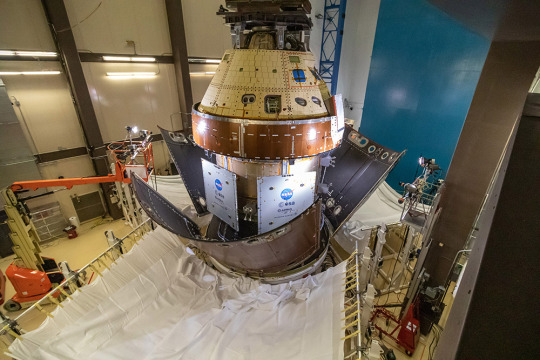
Before NASA astronauts fly Orion on missions to the Moon and back, testing is necessary to verify the spacecraft’s ability to withstand the stresses of launch, climb to orbit, the harsh conditions of deep space transit, and return to Earth. Engineers from NASA and its prime contractor, Lockheed Martin, completed testing on Orion’s Structural Test Article (STA) for Artemis I. The STA is structurally identical to Orion’s main spacecraft elements: the crew module, service module and launch abort system.
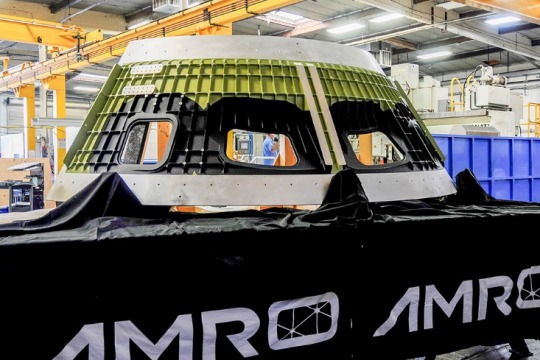
The first element machined for the Artemis III Orion crew module – a cone panel with openings for windows, which will provide a spectacular view – was designed by Lockheed Martin, and manufactured by AMRO Fabricating Corp., of South El Monte, California. The completed panel made its way to NASA’s Michoud Assembly Facility near New Orleans, where engineers will weld it with other elements as part of Orion’s pressure vessel.

Orion’s European Service Module primary structure for the Artemis III mission arrived at the Airbus facility in Bremen, Germany, from its Thales Alenia Space manufacturing site in Turin, Italy. The service module will be equipped with components to power Orion and provide life support to astronauts – such as air, water, heat and cooling -- during the mission that will land the first woman and next man on the Moon.

Three spacecraft adapter jettison fairing panels were fitted onto Orion’s service module inside the Neil Armstrong Operations and Checkout Building at Kennedy. Once secured, the panels encapsulate the service module to protect it from harsh environments such as heat, wind, and acoustics as the spacecraft is propelled out of Earth’s atmosphere atop the SLS rocket during NASA’s Artemis I mission.
768 notes
·
View notes
Text
What is the secret of Apollo 11 landing on the moon?
Hello Friends,
It is a matter of the year 29 July 1969 that the mission of Apollo 11 landed on the moon. In this, two astronauts Neil Armstrong and Buzz Aldrin are sons, Neil Armstrong tries to open the door to land on the moon, but due to high pressure, the door gets jammed. But after a while they succeed in opening. Later try to get out wearing your space suit. Because of their spacesuits while leaving their space. A piece of the Lunar Module breaks off. This thing is broken. This is not known to both of them because there is no sound because there is no wind blowing there. But the piece that was broken was the Ascent Engine Arming Switch, a very important part of the spaceship. Because of this thing, the Lunar Module could not go back to Earth. Unaware of this, Neil Armstrong takes the first step towards Chandpur. And becomes the first person in the world to step on the moon. Did this happen in reality? Even today after 50 years, many people refuse to believe that humans went to the moon. People still make up their own stories and say that the Apollo 11 mission was just a sham. Had lied after all, why was America's agenda waved on the moon? What is the truth behind this? Let's know about this topic today.
Learn more.
#Apollo 11#knowledge#history#information#realty#science#moon landing#fast moon landing#American#cold war
2 notes
·
View notes
Photo
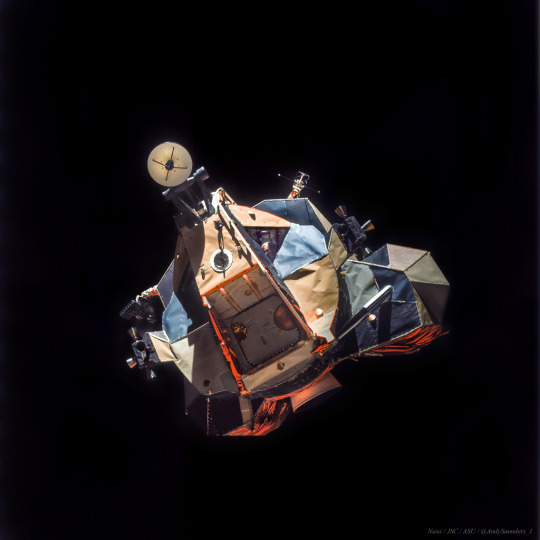
Apollo 17 s Moonship : Awkward and angular looking, Apollo 17's lunar module Challenger was designed for flight in the near vacuum of space. Digitally enhanced and reprocessed, this picture taken from Apollo 17's command module America shows Challenger's ascent stage in lunar orbit. Small reaction control thrusters are at the sides of the moonship with the bell of the ascent rocket engine underneath. The hatch allowing access to the lunar surface is seen at the front, with a round radar antenna at the top. Mission commander Gene Cernan is clearly visible through the triangular window. This spaceship performed gracefully, landing on the Moon and returning the Apollo astronauts to the orbiting command module in December of 1972. So where is Challenger now? Its descent stage remains at the Apollo 17 landing site in the Taurus-Littrow valley. The ascent stage pictured was intentionally crashed nearby after being jettisoned from the command module prior to the astronauts' return to planet Earth. Apollo 17's mission came to an end 47 years ago today. It was the sixth and last time astronauts landed on the Moon. via NASA
239 notes
·
View notes